

Smilin' Through (1922) Norma Talmadge Productions/First National. Produced by Joseph M. Schenck. Supervised by Joe Aller. Directed by Sidney A. Franklin. Adapted by Sidney A. Franklin and James Ashmore Creelman. Photography by Charles Rosher, Roy Hunt. Cast: Norma Talmadge, Wyndham Standing, Harrison Ford, Alec B. Francis, Glen Hunter, Grace Griswold, Miriam Battista, Eugene Lockhart. 8 reels. Copies of this film are located at the Library of Congress (35 mm., some deterioration) and the Nederlands Filmmuseum.
The EYE Film Instituut print is available online at the European Film Gateway with Dutch Intertitles.
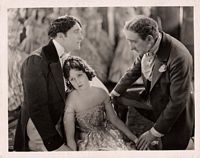 |
Still with Wyndham Standing and Alec B. Francis. Thanks to Derek Boothroyd for these pictures. Click thumbnail to view larger pictures. | 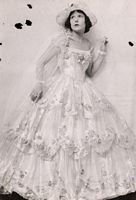 |
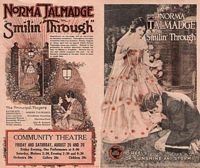 |
A herald, also courtesy of Derek. | 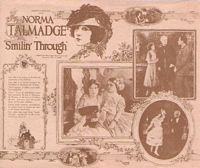 |
See also a still photo from the J. Willis Sayre photograph collection at the University of Washington.
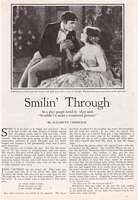 |
Page 1 | 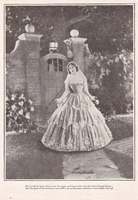 |
Page 2 |
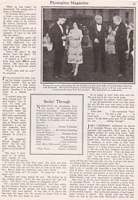 |
Page 3 | 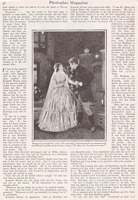 |
Page 4 |
 |
Page 5 | 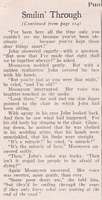 |
end |
| Kathleen Moonyeen |
Norma Talmadge |
| John Carteret | Wyndham Standing |
| Kenneth Wayne Jeremiah Wayne |
Harrison Ford |
| Doctor Owen | Alec B. Francis |
| Willie Ainsley | Glen Hunter |
| Ellen | Grace Griswold |
| Little Mary (Moonyeen's sister) | Miriam Battista |
| Village Rector | Eugene Lockhart |
Joseph M. Schenck produced the screen version of "Smilin' Through" as a starring vehicle for Norma Talmadge for release through First National. The screen adaptation of the Allen Langdon Martin play of the same name is credited to James Ashmore Creelman and Sidney A. Franklin, with the latter also the director.
"Smilin' Through gained recognition as a stage success with Jane Cowl as its star. For the screen adaptation Miss Talmadge ably handles the leading role and gives to the production a stamp of class in the acting division that places it well up on the list of program features.
The theme is based upon love and hate. With these two valuable assets to work with, Director Franklin has turned out a feature with all the necessary heart interest to warrant its success.
The story centers around the life of John Cartaret. On his wedding day his bride is killed by a rival suitor. Years later his adopted niece falls in love with the son of the man who had committed the crime. Hate had predominated the life of Cartaret for all members of the family of the murderer. That his niece had fallen in love with the culprit's son sends his blood to a boiling point. Only after much persuasion is to make to see the light, with the story culminating in a happy romance for the young couple. Cartaret dies peacefully after having been won over to the other side.
"Smilin' Through displays expert direction. The punches are landed effectively. A capable cast works up the big points, with Wyndham Standing and Alec B. Francis giving the star excellent support. The production end, not calling for a large outlay, is artistically worked out, with the director displaying discretion in his selection of exteriors.
The high esteem in which Norma Talmadge is held by picture patrons will not be impaired by her latest production. It will give satisfaction as a program feature.
SMILIN' THROUGH, with Norma Talmadge, directed by Sydney A. Franklin, adapted by James A. Creelman from the play by Allen Langdon Martin [actually Jane Cowl and Jane Murfin]; "Felix All At Sea," a Pat Sullivan animated cartoon; prologue to "Smilin Through," sung by Frank Mellor, quartet and ensemble. At the Strand.
The chances are that practically all those who inform themselves about "Smilin' Through," at the Strand this week, and then go to see it, will enjoy it. For it is entirely sentimental, and it is well done. Those who like photoplays deliberately sentimental will be attracted to it, therefore, and will find what they are looking for. Those who shy at such will not be attracted, and will stay away. So there'll be satisfaction all round. It's a happy division, isn't it?
Many, no doubt, remember the substance of "Smilin' Through," but for the benefit of those who, like the present writer did not see the play it may be stated briefly that it is about the tragic love of John Carteret and Moonyeen, and the happily consummated love forty years later, of Kathleen, Moonyeen's niece, and Kenneth Wayne, the nephew of the man who had wrecked the happiness of Carteret and Moonyeen. The situations of the photoplay are brought about by the fact that Carteret, a disappointed old bachelor, opposes the marriage of his dead bride's niece to the nephew of the man responsible for her death. His life is controlled by his love for Moonyeen and his hatred for any one of the name of Wayne, and it is not until he throws off his hatred and surrenders himself completely to his love that he makes happiness possible for the young people and finds it himself in spiritual union with Moonyeen.
The dead bride is kept personally in the main story and her union with Carteret at the end is actualized by means of spiritualistic manifestations, and it is in presenting these, as may be imagined, that the photoplay becomes most characteristically and expressively a motion picture. The scenes in which the spirits appear are the best, from the cinematographic point of view, and also, it would seem, from the sentimental. They are all effectively done, especially that in which the rejuvenated spirit of Carteret leaves its aged body to join the eternally young spirit of Moonyeen.
Chief among the other attractions of the photoplay, in addition to its photography and settings, which, on the whole, are exceptionally good, is Norma Talmadge. She is lovely as the Mid-Victorian Moonyeen and charming, too, as the more modern Kathleen. Also, her pantomime is often tellingly expressive.
Wyndham Standing, as Carteret, is not so satisfactory. He has relatively little to do as a young man, as most of the action of the story takes place after he, in his role, has grown old, and it is as an elderly man that he fails to be convincing. His make-up is good, and some of his scenes are played smoothly, but too often he seems self-conscious, awkward in a part that is new to him. His gestures and expressions frequently seem the stock gestures and expressions memorized by an actor for an old man's part. They do not seem the natural gestures and expressions of an old man. Especially in contrast with the easy naturalness of Alec B. Francis, who plays with him in many scenes.
Harrison Ford, as Wayne, junior and senior, is adequate, as are the others in the cast.
The Strand Theatre was eight years old last week, having been opened on April 11,1914, but the management has chosen this week for the celebration of the anniversary. The bill is presented as something special and there is a brief, but interesting, historical sketch of the theatre in the program. The latter is incomplete, however, in that it makes no mention of the first managing director of the Strand, S.L. Rotthafel, now in charge of presentations at the Capitol.
Applause for "Smilin' Through"
Editor, Photoplay Magazine.
Dear Sir:
May I, through the medium of your magazine, present a large bouquet to Miss Norma Talmadge for her superb acting in "Smilin' Through"? I know it is rather late in the day, but my excuse is that the film was not released over here until the eleventh of September.
While her whole performance was absolutely flawless, special mention must be made of her portrayal of the death of Moonyeen. There was no writing of limbs, or clinching of hands, or rolling of eyes; just one spasm of pain and then a slow sinking into oblivion. I do not think I have ever seen a death scene more beautifully or naturally played.
To my mind, her performance deserves to rank with Miss Lillian Gish's Henriette, and Miss Mae Marsh's Dear One as the best acting ever seen on the screen.
"Smilin' Through"
"Smilin' Through" is a personal triumph for Norma Talmadge.
Translated, for business purposes, into the language of dollars and cents, the above paragraph means money for exhibitors. Miss Talmadge's following will see to that. In fact, she has more than a following, and her multitude of admirers will enthuse over her performance in this picture, which is an adaptation of the play in which Jane Cowl met with tremendous success last year. Some persons will say Miss Talmadge exceeds anything she has done before, but at any rate everyone will agree she at least equals it. She plays a dual role and in each character she makes a display of acting ability in a restrained manner, that is an achievement of the highest type, suggested by her particular beauty which is set off by highly advantageous photography.
Others stars of the production who deserve special mention are the two artists in their line who were responsible for the photography, Charles Rosher and Roy Hunt. The story of "Smilin' Through" is of the type that needs unusually artistic camera work and these two men obliged with co-operation that gives the picture a rarely beautiful quality. The ghost stuff is unusually well done. In the distribution of credits Sidney A. Franklin, the director, should come in for a generous share, and Mr. Franklin and James A. Creelman should not be neglected for their ably constructed scenario adapted from an original that presented difficulties from a continuity standpoint. A great deal of the story traverses the flashback route, and this is well threaded in.
The cast gives Miss Talmadge worthy support. Wyndham Standing does some of the best work of his career and Alec B. Francis, who can always be relied upon for a good performance, is fine. Glen Hunter makes a small part stand out, and Harrison Ford is excellent in spite of the fact that he frequently appears to be a typical Broadway juvenile. Miriam Battista is, as usual, lovely.
The story of "Smilin' Through," when presented in stage form, seemed to be liked, even though it is founded upon one of the most overworked themes used in spoken or silent dramas--that of the family feud that prevents the marriage of two of the younger generation because of the hatred of the guardian of one for the antecedents of the other. There is no reason to believe that the story will not reach the same popularity in screen form. Possibly it has so many attributes of rare beauty that its familiarity is quite overshadowed.
Besides, the charm Miss Talmadge will have upon all witnesses, it is this beauty of the presentation of a story that is bound to have unusually wide appeal that assures success for the picture.
The Cast
| Kathleen Moonyeen |
Norma Talmadge |
| John Carteret | Wyndham Standing |
| Kenneth Wayne Jeremiah Wayne |
Harrison Ford |
| Doctor Owen | Alec B. Francis |
| Willie Ainsley | Glen Hunter |
| Ellen | Grace Griswold |
| Little Mary (Moonyeen's sister) | Miriam Battista |
| Village Rector | Eugene Lockhart |
Adapted from Allen Langdon Martin's Play.
Scenario by James A. Creelman and Sidney A. Franklin
Directed by Sidney A. Franklin
Photographed by Charles Rosher and Roy Hunt
Length, Eight Reels
The Story:
In the bitterness of his hate against the whole Wayne family--for twenty years before John [sic] Wayne, the rejected suitor had shot and killed his beautiful Moonyeen, his bride to be--John Carteret has sternly denied his ward, Kathleen, the niece of the dead Moonyeen, her love for Kenneth Wayne, nephew of the man who wronged Carteret. Kenneth is a fine young man, worthy to win any girl's love, but Carteret can see only the bitterness of his own tragedy.
Through the vale of years and space are nothing and Moonyeen yearns to come to her lover, she finds the only obstacle her love cannot span--the hate dominating Carteret's soul.
War comes and takes Kenneth with thousands of other fine men through four years of anxiety and torture. Carteret has ordered him away, but Kathleen has told him she will be waiting.
Peace comes but not Kenneth. And from another Kathleen learns that his has returned badly "shot up." Returning crippled he refuses to hold Kathleen to her promise. She, thinking him in love with some one else, gives him up, but blames the cruel hatred of John Carteret for her sorrow and determines to leave him.
Faced by the disaster of his losing the only living love life holds for him, Carteret appeals to his friends. He finds the love of Kathleen stronger than any hate, calls back Kenneth, and with the realization that love permeates his soul the spirit of Moonyeen is able to penetrate the barriers and come to him again.
Exploitation Angles: Play up the star as strongly as you can afford, for the star will sell the tickets, but get all you can make out of the stage success. It should need no stunts to put this over, if you spread the star's name.
"Smilin' Through is a Triumph
It is proper in these hours of darkness, just before the dawn of prosperity, which inevitably is bearing down upon us, to speak first of the box office value of a production. Will it make money? Will it make up for this or that loss sustained on pictures that failed to bring in the crowds?
It is our opinion that "Smilin' Through," with Norma Talmadge, will reach its big money pinnacle next Fall, and that in the meantime it will bring heavy cash returns if anything like enthusiastic showmanship is put behind it.
First National has released a big "start of the season" attraction in the Spring of the year. This is good business for the exhibitor, and the picture is so great in its appeal that it will certainly justify this confidence in its ability to continue in popular favor for many months to come
Make 'em laugh or make 'em cry. This is the showman's alternative at any time that he does not feel justified in taking a chance. "Smilin' Through" makes 'em cry in a satisfying, comforting sort of way by a legitimate appeal to human sympathy. Its moral tone is perfect. Its example is superb and its effect of the public is the finest kind of argument against censorhship or newspaper attack. Beautifully made, charmingly acted by a well chosen cast--Miss Talmadge at her most delightful best in a story that draws the sharp contrast between love and hate--this is the picture. And what a picture, for the every-day folk and for those of exalted station, whose tear ducts have not dried up and whose throats still can experience the choke of genuine emotion. Sidney A. Franklin has brought Miss Talmadge out as no other director has done.
We recommend "Smilin' Through" as in all respects, a safe, satisfying success, and we are willing to let our judgment be sustained by the box office results. Our only astonishment is that First National has made so little noise about it.
Smilin' Through (1922) was adapted from a play by Jane Cowl and Jane Murfin, and was popular enough to generate two remakes. It is a transitional film in Talmadge's career. It is the last of her double roles, and first film taking place at least partly in the past. It was also the last film made at her New York Studios, intimate, with limited sets, yet it has the glossy look and bigger "feel" of her later Hollywood films. Talmadge borrowed Mary Pickford's photographer Charles Rosher, and the results are gorgeous, she never looked lovelier.
Viewers familiar with the remakes may find the film disappointing at first--many of the most charming scenes of the remakes were not in the original play, which the silent version follows fairly closely. It emphasizing the uncle's hatred of the young man Wayne and love of Moonyeen, including some rather weird scenes of his trying to recall the spirit of Moonyeen in the moonlight with a doll she had given him just before her death. In a way this fidelity to the play is rather unfortunate, since Wyndham Standing is less than stellar as the uncle, while the Talmadge and the soulful-eyed Harrison Ford would have been ideal for the emphasis on the spiritual bond between the young lovers which was the focus of the later remakes. The main lines of the story are the same, however, as is the resolution--that the feud cannot be put to rest until Wayne is cripped (symbolically castrated?), to atone for the sins of his father and release Carteret from his burden of hate, enabling him to die and rejoin Moonyeen.
The film is quite lovely, and would benefit from a lush, romantic score. Talmadge has opportunity for scenes of drama as well as some bits of comedy, and her charm was never better exhibited than here. It was her biggest hit and one of her most beloved and well-remembered films.
Print viewed: 35mm from the Library of Congress. A couple of scenes have significant deterioration
December 2014
Finally watched the online Dutch print. It appears to be in beautiful condition, and many scenes are nicely tinted. It must be the European print, since it has different takes and often slightly different camera angles. For example, when Glen Hunter retrieves a book from the cabinet in the LOC print, he drops it, but does not in the Dutch print. The shots and editing are very close between the two versions. It lacks the art titles present in the LOC print, and Dutch title translations are much longer than the English titles. It does have one additional scene not appearing in the LOC print, a scene of Norma in her room writing letters right before Alec B. Francis arrives at the garden gate with a letter for her. The
Print viewed: Online stream of 35mm tinted print from the EYE Film Instituut with Dutch titles
Bob Fells has posted a comparison between a scene in the two versions.
Last revised, December 29, 2016